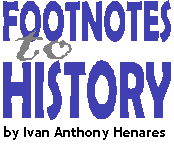|
Big Brown Filipino
There is more to San Fernando's historical core than Barangay Santo Rosario and Consunji Street. Few people may have noticed the quaint turn-of-the-century residence along Del Pilar Road, a few meters from Baluyut Bridge. It may not match up to the elegance of the bigger colonial mansions we are more acquainted with. But the prominence of its former resident adds a great deal to its historical importance. Alongside the main entrance are a group of nameplates, one of which reads: Vivencio B. Cuyugan, Mayor of San Fernando 1938-1946, First Socialist Mayor of the Philippines.
Vivencio Cuyugan y Baron was born in San Fernando on January 13, 1895 to Saturnino P. Cuyugan and Antonina Y. Baron. He was "unusually tall, large and bulky for a Filipino," and in fact looked like a "powerfully-built Caucasian."
According to a biography written by Dr. Ruben Santos Cuyugan, he left for Chicago in 1917 to take up law at Northwestern University. This was the very same university where his townmate, Jose Abad Santos, received his law degree. This sojourn to the United States was made possible through a slim grant from his aunt. But he was left to fend for himself when he got there and supported himself through professional boxing. His prowess in boxing earned him the moniker "Big Brown Filipino."
His stay in America was cut short however because of a celebrated incident in 1926. Together with a friend from Batangas, a Marasigan, the two decided to ignore a sign prohibiting Filipinos from entering a cabaret. At this time when the idea of racial equality was still in the drawing boards, ignoring such signs was no good idea. The crowd inside immediately ganged up on Marasigan. And in the fracas that ensued, Marasigan's ear got cut off. Seeing what had happened to his friend, Cuyugan told his friend to stand aside and went into action. The result - he ended up in jail, and everyone of his attackers in the hospital.
Bail was set for two hundred thousand dollars. But the Filipino community rallied to his defense. They hired one of the greatest criminal lawyers, Clarence Darrow, to plead his case. He was soon acquitted and decided to return to the Philippines afterwards. While in jail, Cuyugan was the subject of newspapers in both the Philippines and Chicago. He was now returning home, a celebrated hero.
A short while after his arrival, in 1927, Cuyugan was appointed municipal vice-president of San Fernando. He would later be elected to the same position in 1931, and later, the first mayor of San Fernando under the Philippine Commonwealth, the first Socialist in the Philippines to be elected mayor.
Vivencio Cuyugan was one of the voices of the oppressed, a mission he had lived for even while in Chicago. Here, he became the defender of the laborer, the landless and the peasant farmer. Although part of the upper class, he was also able to identlify himself with the lowly and soon joined socialist movement leader, Pedro Abad Santos, in creating the Socialist Party.
As mayor, Cuyugan dared to go against big economic interests in the town. In another celebrated incident, he went after PASUDECO, the biggest sugar central in Central Luzon, for dumping waste into the San Fernando River and polluting it. Then councilor, and later mayor of Manila, Manuel C. de la Fuente was one of those who sided with these big economic interests and commented adversely to Cuyugan's action, calling him a "no-brain" mayor. And just like a repeat of his Chicago experience, Cuyugan immediately challenged de la Fuente to a personal duel. De la Fuente accepted. But when the appointed hour of the duel approached, de la Fuente was a no show, running off to Batangas to seek the intervention of Jose P. Laurel.
When the Japanese Imperial Army invaded the town, Cuyugan resigned as mayor and together with other Socialists, who included Luis Taruc, Mayors Casto Alejandrino and Mariano Sampang, Apung Banal and others, founded the Hukbong Bayan Laban Sa Hapon (Hukbalahap). He served as its first Commander-in-Chief. But due to a stroke, he was forced to turn over the helm of the guerilla movement to Luis Taruc.
Meanwhile, the Japanese used the sequestered Cuyugan Residence as the temporary seat of the municipal government, since the municipio was burned down. This adds to the historical significance of the house.
After the war, Cuyugan was reinstated as mayor of San Fernando, but was soon replaced due to his uncompromising position in defense of the continuing struggle of the Hukbalahap. He lived in semi-retirement after this save for a few incidents. He was asked to testify against Claro M. Recto on charges of collaboration, but refused saying "over his dead body." He was also imprisoned for six months in 1953, during the term of President Ramon Magsaysay, on the charge that he was one of the leaders of the Communist Party. Cuyugan died in 1971.
We may have lost the Abad Santos house, but there are many more structures worth saving in the City of San Fernando, such as the residence of Vivencio Cuyugan. Each edifice has its own story to tell. And little known accounts such as these make us value our historical and cultural heritage more than ever.
Please send your comments or suggestions to
ivanhenares@yahoo.com.
We would like
to request those who will be using the information above, especially for
publication, to properly cite the author and the Kapampangan Homepage. The
above column was published in Sun*Star Pampanga.
|
|

